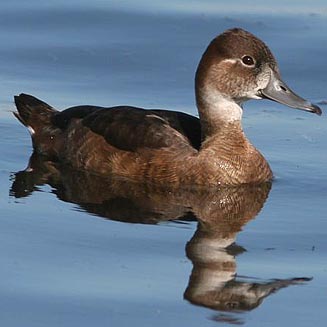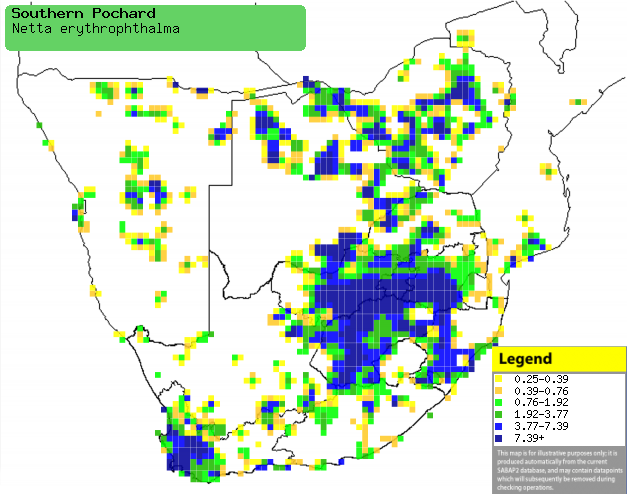|
Netta erythrophthalma (Southern
pochard)
Bruineend [Afrikaans]; Letata (generic term for duck)
[South Sotho]; Dada, Sekwe (both are generic names for duck or goose) [Shona];
Xinyankakeni [Tsonga]; Sehudi (generic term for duck) [Tswana]; Zuidelijke
tafeleend, bruine krooneend [Dutch]; Nette brune [French]; Rotaugenente
[German]; Zarro-africano [Portuguese]
Life
> Eukaryotes >
Opisthokonta
> Metazoa (animals) >
Bilateria >
Deuterostomia > Chordata >
Craniata > Vertebrata (vertebrates) > Gnathostomata (jawed
vertebrates) > Teleostomi (teleost fish) > Osteichthyes (bony fish) > Class:
Sarcopterygii (lobe-finned
fish) > Stegocephalia (terrestrial
vertebrates) > Tetrapoda
(four-legged vertebrates) > Reptiliomorpha > Amniota >
Reptilia (reptiles) >
Romeriida > Diapsida > Archosauromorpha > Archosauria >
Dinosauria
(dinosaurs) > Saurischia > Theropoda (bipedal predatory dinosaurs) >
Coelurosauria > Maniraptora > Aves
(birds) > Order: Anseriformes
> Family: Anatidae
 |
 |
|
Southern pochard male, Strandfontein Sewerage
Works, South Africa. [photo Trevor Hardaker ©] |
Southern pochard female, Strandfontein Sewerage
Works, South Africa. [photo Trevor Hardaker ©] |
The Southern pochard is common, and has a population
scattered across southern Africa. It lives in wetlands, where it feeds mainly on
the seeds and leaves of aquatic plants. It is a monogamous, solitary nester, the
female building its nest out of leaves and stems, placing it on embankments
surrounded by dense vegetation. It lays 4-16 eggs, which are incubated solely by
the female, for 20-28 days. The chicks, once hatched, are immediately led by
their mother to water, where they are capable of diving and swimming. The
brood fledge at 49-65 days old.
Records
| Heaviest adult female |
1018 g |
| Heaviest adult male |
1010 g |
| Lightest adult female |
484 g |
| Lightest adult male |
592 g |
| Longest living |
6 years 8 months |
| Longest distance travelled |
> 3000 km |
Distribution and habitat
Found in North and South America,
as well as in Africa south of the Sahara. (Eritrea and Angola through to
southern Africa). In southern Africa it can be found where there are wetlands with deep, clear water and emergent vegetation.
|
 |
|
Distribution of Southern pochard in southern Africa,
based on statistical smoothing of the records from first SA Bird Atlas
Project (©
Animal Demography unit, University of
Cape Town; smoothing by Birgit Erni and Francesca Little). Colours range
from dark blue (most common) through to yellow (least common).
See here for the latest distribution
from the SABAP2. |
Movements
It is quite mobile, as birds ringed
in the North-West Province have been found in northern Namibia, and even Malawi,
Zambia, Tanzania and Kenya, more than 3000 km away!
Predators and parasites
- Lice
- Anaticola crassicornis
- Anatoecus icterodes
- Holomenopon leucoxanthum
- Trinoton querquedulae
- Theromyzon cooperi (African duck leech)
- On one pan, 1.8% infected with Clostridium botulinum (Botulism)
Food
It feeds mainly on plant products, with
very small amounts of invertebrates making up the rest of its diet. It usually
forages by
diving, sometimes travelling 18 m. It also dabbles
and, uncommonly, forages on waterside vegetation.
- Plants
- Nymphaea (water-lilies) seeds, rhizomes and corms.
- Nymphaea nouchali (Blue water-lily)
- other species
- Nymphoides indica (Small yellow water lily) seeds, rhizomes and
corms.
- Typha domingensis (Bulrush) seeds
- Scirpus littoralis (Steekbiesie) seeds
- Papsalidium geminatum (Swamp grass) seeds
- Aeschynomene pfundii (Knuckle-bean) seeds
- Oryza sativa (Wild rice) seeds
- Dicotyledons seeds
-
Invertebrates
Breeding
- Monogamous solitary nester, often with nests only a
few metres apart. Courtship is elaborate, involving
unique calls, preening, and head bobbing.
- The female builds the nest, using materials from nearby aquatic plants.
The nest is a broad bowl, 30-40 cm wide and about 8 cm deep, built with
leaves and stems of aquatic plants, sometimes lined with down feathers. It
is usually placed in thick vegetation (e.g. reeds or sedges) on the water's
edge or up to 20 m away. Rarely, it
uses old nests of Fulica cristata (Red-knobbed coot)
- Laying dates are as follows:
| |
Jan |
Feb |
Mar |
Apr |
May |
Jun |
Jul |
Aug |
Sep |
Oct |
Nov |
Dec |
| Namibia |
|
x |
x |
x |
|
|
|
|
|
|
|
|
| Botswana |
x |
x |
x |
x |
|
|
|
|
|
x |
x |
|
| Zimbabwe |
x |
x |
x |
x |
x |
x |
x |
|
x |
|
|
x |
| North-eastern South Africa |
x |
x |
x |
x |
x |
|
x |
|
|
|
|
x |
| Free State Province |
x |
x |
x |
|
x |
x |
|
|
|
|
|
|
| KwaZulu-Natal |
x |
x |
|
x |
|
|
x |
x |
|
|
|
x |
| Eastern Cape |
x |
x |
x |
|
|
|
|
|
x |
x |
x |
x |
| Western Cape |
x |
x |
x |
|
|
x |
x |
x |
x |
x |
x |
x |
| Northern Cape |
x |
x |
x |
x |
x |
|
|
x |
x |
x |
x |
|
-
It lays 4-15 eggs, at 1 day intervals, which are
incubated by the female for 20-28 days.
-
The chicks, once hatched, are immediately led by their
mother to the water, as they know how to dive and swim by instinct, The
chicks fledge at 49-65 days old.
-
The chicks feed for themselves, with the female
disturbing floating vegetation by sweeping its bill while the chicks
grab bits of food. The chicks eat about 20% insects and 80% plant matter. The
following food items have been recorded in the chicks diet:
 |
|
Southern pochard with chicks, Nylsvley, South
Africa. [photo
Warwick Tarboton ©] |
Threats
- The Southern Pochard is not threatened, in fact it has benefited greatly
from human development.
References
-
Hockey PAR, Dean WRJ and Ryan PG (eds) 2005. Roberts
- Birds of southern Africa, VIIth ed. The Trustees of the John Voelcker
Bird Book Fund, Cape Town.
|
